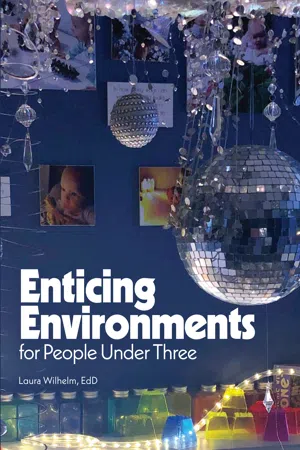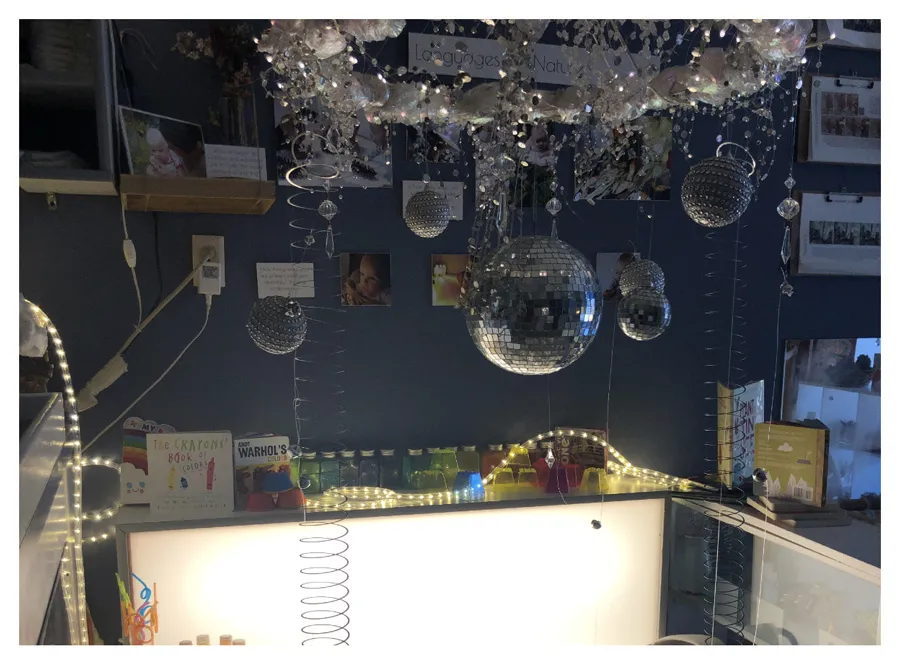![]()
Chapter 1:
The Brilliance of Babies, Toddlers, and Twos
Babies are brilliant. If you don’t believe it, spend just a few minutes watching a very young child explore a novel object. You can almost see the little wheels turning in her mind. A person under three years old has a mountain of work ahead of her. In just a matter of months, she will begin to figure out how her body works: how to grasp, to roll over, and then to sit, stand, climb, and run!
Even newborn babies display impressive capabilities and curiosity as they respond to caregivers and learn to elicit responses from the ever-expanding world around them.
Babies are born scientists. They are prewired for curiosity and discovery. We can see that they are beginning to build a concept of themselves when they start to play with the “baby in the mirror.” It’s evident that they are building an understanding of the world beyond their own bodies when they register surprise at the unexpected. We don’t have to wonder whether they are ready to learn something new—when they are ready to try out a new skill, they simply do it! Our job is to pay careful attention and use their cues to help us provide safe, appropriate environments where they can thrive. Strive to see babies as intently as they see us.
Elinor Goldschmied was an educator who worked with orphaned babies who were kept in group care during and after World War II. To convey her deep respect for babies, she used the term “people under three”—not “little ones,” which can sound condescending, or even infants, which can sound distant like medical terminology. At the time, people thought that babies were cute but not very capable. Many thought they interacted with the world only to cry, sleep, and eat. Researchers (even as recently as the 1980s!) thought that, due to immature pain receptors, babies could not really experience pain. Parents were told, “Oh, it doesn’t really hurt to draw blood from the bottom of a newborn’s foot.” Science is now teaching us that babies do feel pain, much like adults do. Babies are much more aware and interactive than people have assumed—something that Goldschmied understood. Today, researchers are finding new ways to demonstrate what babies already know and how they are continually learning.
In some ways, we’ve underestimated babies’ capabilities. Repeated altruism studies (Warneken and Tomasello, 2006; Hu, Li, Jia, and Xie, 2016; Barragan, Brooks, and Meltzoff, 2020) have demonstrated that toddlers as young as fifteen months will help others, even when there’s no reward for themselves and even when they have to overcome obstacles to help another person. Young children are not only capable; they will go out of their way to be helpful, especially when they have had previous interactions with the person who needs their help.
We also overestimate young children. A toddler may demonstrate an interest in numeracy, arranging objects one by one. Although this play is laying the foundation for later arithmetic, this behavior does not mean the child is ready for math problems. Despite the commercials you may have seen featuring very young children recognizing letter patterns and imitating reading-like behaviors, babies do not need to learn to read—not yet. The time invested in teaching babies these academic-looking tricks would be much better spent playing with them.
By following their lead and facilitating their discoveries, we can help babies build on their current level of understanding. Children will show us what they need, if we pay attention; their every behavior is communicating information. Babies need to be nurtured and given lots of interesting experiences, which build a strong foundation for the academic instruction that will come later. The first years are a time for exploration and learning with all the senses. When we closely observe spontaneous play, we can see a child’s current understanding and can plan ways to present new challenges.
Pediatrician T. Berry Brazelton and his colleagues created an instrument called the Neonatal Behavioral Assessment Scale (NBAS) to showcase the abilities of newborns. The scale teaches families that their newborns are already learning and using inborn reflexes. For example, from the very first day of life, babies show preference for familiar voices. If you hold a newborn baby in your arms and have a parent speak on one side and a stranger speak on the other, the baby will turn toward the parent.Cells in the brain called mirror neurons allow babies to imitate the facial expressions of people around them. For example, even brand-new babies can imitate tongue thrusts. If you stick your tongue out at a baby a few times, she will slowly start sticking her tongue back out at you! (Try it with the child of friends. They might wonder about you, but they will be impressed with their newborn’s skills.) Babies can identify their own mothers’ milk by smell from the day they are born. They can track a small red ball with their eyes. And they will make reflexive stepping motions when you hold them upright. When parents are shown these capabilities, they begin to see their baby as a person who knows them already. We don’t have to wait years to begin teaching them; babies are already learning from day one. As humans, we are programmed to view our own children as very special. Our preference helps us protect them. The NBAS helps us see them as learners as well.
Yes, reading to young children is important for their development, but so are singing, dancing, talking, and playing. Objects in the environment present opportunities for learning. Very young children learn through all their senses: touch, taste, smell, sight, and sound. They are drawn to interesting textures, such as woven baskets and wooden blocks. After the age of six months, when babies are introduced to solid food, allowing them to explore it with their fingers combines nutrition with lessons about taste, texture, smell, and sound. Toddlers can identify vegetables by taste, color, and shape as they select what to eat next.
Babies respond to our singing—even when we sing badly. They love laughter, the noises they make with their own voices, kicking, and banging objects. When babies babble, they take turns, pause, and gesture at the same rate as adults who are having a conversation. Their voices rise in pitch before a pause to indicate questions, and at other times, they can sound very emphatic. Babies’ babbling mimics the languages that they hear used most often.
Babies need freedom of movement to explore the world and to develop their muscles. While playing indoors and outside, they need to be able to push up, roll over, squirm, and kick. They need time on the floor on their tummies to strengthen the muscles in their arms, necks, and shoulders by pushing up. They will use these muscles later for crawling. They need time on their backs to relax, stretch, and kick. Once they can roll over, they’ll start to find ways to scoot their bodies toward interesting objects. They cannot do any of these things when they’re strapped into the seat of a bouncer or swing.
Some babies do love to be in those containers, but they should always be taken out of them within 20 minutes because the containers limit babies’ range of motion and muscle development. So-called “walkers” don’t teach babies how to walk, because babies in them aren’t supporting their own weight. Very young children need lots of opportunities to pull up to a standing position and to cruise along pieces of furniture as practice for later walking.
Enticing, Engaging Environments
Appropriate environments are part of the educational curriculum for our youngest citizens. Carefully planned environments nurture curiosity and invite children to explore and experiment with their own ideas. When babies crawl on the floor, little fingers love to try to fit into a tiny knothole in the floorboard. Crawlers are drawn to discover interesting textures such as woven mats, smooth tile floors, rubber pads, and soft carpets. Toddlers become obsessed with walking and running as soon as they are able. They love toys that they can push and pull, and they enjoy climbing steps or stairs. Two-year-olds can be very creative and may begin to create storylines to narrate their play with blocks and puppets. For example, as he entered our school each morning, a two-year-old made a ritual of turning two fabric birds with wire legs facedown on the table as he walked past my office. After a few days, his mom explained his reason: “So they could eat.”
Big eyes are drawn to beautiful patterns displayed at the child’s eye level. To see for yourself what the children are seeing, get down on the floor. Observe what is visible near your ankle height. What do you notice? Do you see table legs, shoes, and shelving? Is there anything interesting that a baby might want to scoot, roll, crawl, or toddle over to investigate? On your knees, look at the room from your normal elbow height to replicate the view when babies are being cuddled in a lap. How does the room look different from here? Is there artwork on the walls? Do you see mobiles made of interesting items? Stand and examine what is visible at your shoulder height when babies are lifted or carried. Can you see outside through a window? Do you notice a loft to explore or a mobile to gaze at?
Babies, toddlers, and twos appreciate beautiful design and calming interiors just like adults. Rooms should feature beautiful artwork, have blank spaces where eyes can rest, windows to see outdoors, and mirrors to reflect light and allow babies to see their own and others’ faces. Paint the walls in comforting colors that fade into the background, so that the focus of the classroom is on children’s work and not the walls. Artwork should be lovely to look at; display children’s art projects respectfully. For example, if children have explored making marks on large sheets of paper, trim the edges evenly rather than just ripping the paper off the roll. Take a little extra time to tape paintings and drawings into empty picture frames or mats, and hang them on the walls where the children can see them. Consider using open-topped Plexiglas frames, which will allow you to change out photos and artwork from time to time. You can safely display the images near the floor where young children can view them up close.
Offer Places and Things to Explore
An open floor plan with a clear line of sight allows for supervision by sight and sound at all times, which is necessary for safety. Babies need open floor space where they can move, and they need opportunities to explore the environment safely. In an area for babies, provide rugs and mats that have soft and inviting textures where they can lie on their backs or tummies, protected from mobile children by shelves or gates. Provide a variety of easy-to-clean surfaces for rolling, scooting, and crawling, such as linoleum, wood, tile, or vinyl flooring—especially in the feeding, diapering, sensory, and art-exploration areas. You can add variety and interest with temporary texture additions to your classroom floor. Try duct-taping squares of burlap, cotton fabric, and even contact paper turned sticky side up for the children to check out. Babies love to touch their families’ and friends’ photos when displayed under clear contact paper on a smooth floor.
Give babies low, sturdy shelves to pull up on and crawl through. Provide interesting things to look at and move toward, such as unbreakable mirrors, artwork, open space, plants, windows, photographs, and mobiles. Offer safe things to grasp, such as balls made of rolled socks, yarn, cloth, or wicker; pretty handkerchiefs or small scarves; sponges; lightweight kitch...



